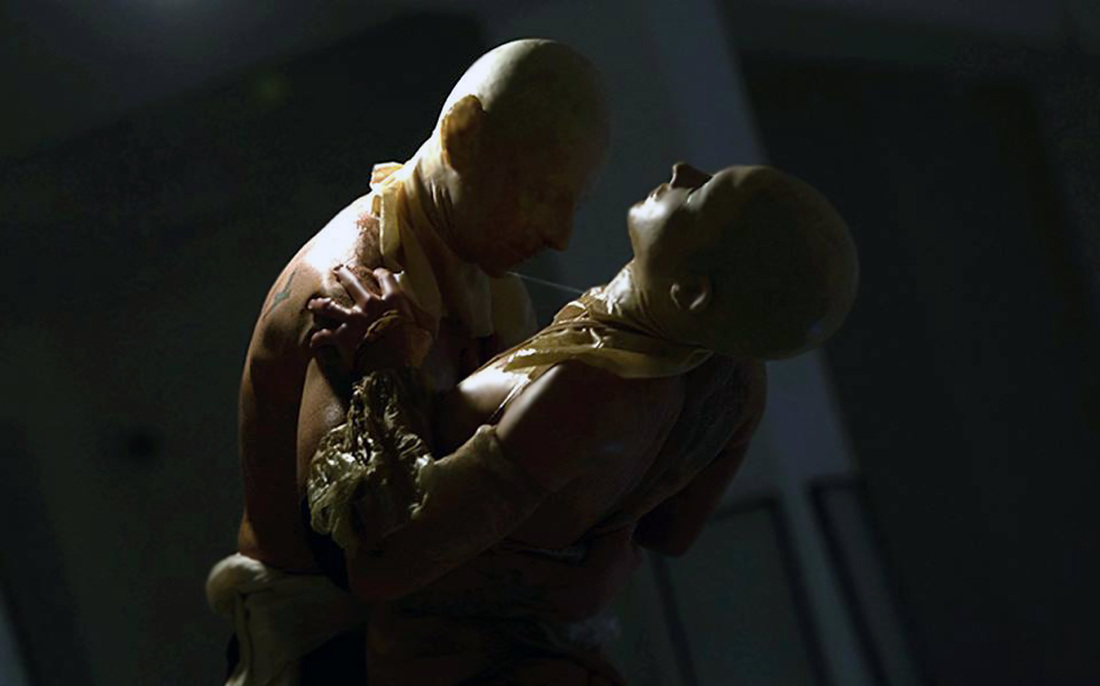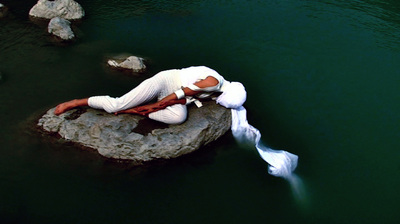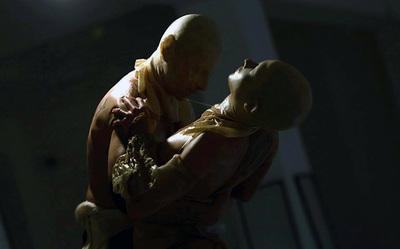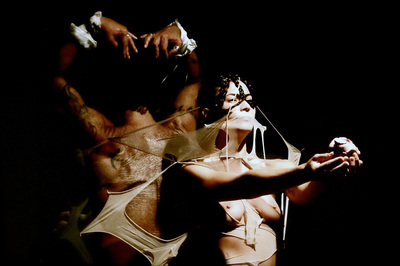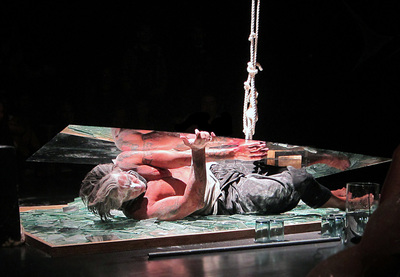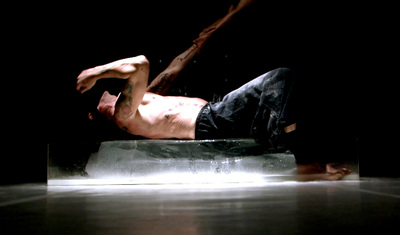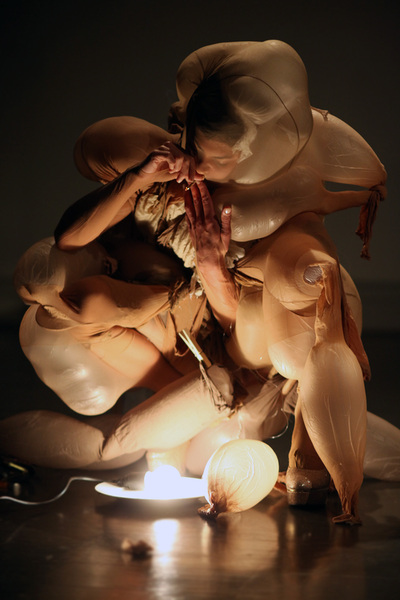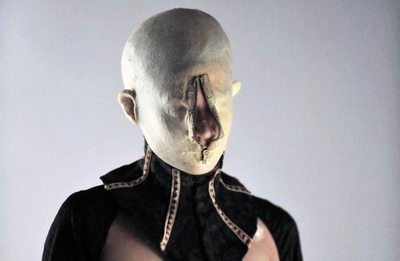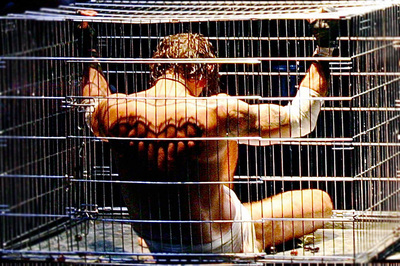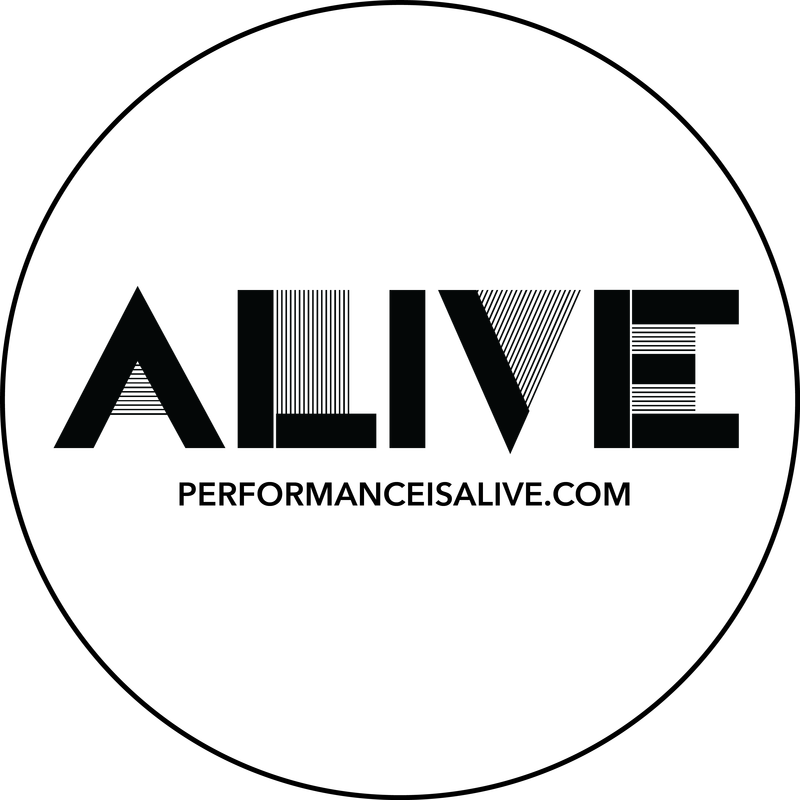|
For our next Artist Feature, we present the work and words of a provocative and ambitious performance art duo, VestAndPage, Verena Stenke (DE) and Andrea Pagnes (IT). Not only does the collaborative present performances and workshops across the globe, but they also curate the Venice International Performance Art Week. I was lucky enough to meet the pair at Grace Exhibition Space in Brooklyn, NY for their MayDay workshop (2010). During the workshop, VestAndPage reconnected us (the participants) to our bodies, to our breath, our heart rhythms, our physical agility and emotional fragility. It is through these same physical and emotional connections that the pair explores their own work.
For this feature, I asked Verena and Andrea to discuss their approach toward live performance versus film, their evolution toward performance art and inspirational/influential artists - questions that I deem integral to this site. They provided wonderfully elaborate and insightful responses of which you can find in full below. I hope you enjoy - Quinn Dukes
Quinn Dukes: What led you to performance art?
Verena: I appreciate that your formulation of the questions implies that kind of crucial, conscious passiveness, which allows us to be led towards something previously unknown. Andrea: Yes, just as pertaining in part to the concept of Panta Rhei, or ingrained in the precepts of Zen Satori. This brings us to understand in which way we perceive our process, by seeing our self-nature, deepening our experiences and bringing them into maturation to finally shape them into an art form, never abandoning the support of a continuous practice. It is a matter of comprehension, every day. Always from now on: looking backwards to go towards. Verena: In the moment that we met, it was as if many previous happenings already were under a certain star - as with any guidance- though we might not yet have labelled with these words, nor prospected what would have happened. From this perspective, life itself meld with decisions and turns taken at crossways, answers to calls, steps through doors that opened, climbed hills, led us to where we are now and the art we make. Andrea: The core of our main interests and artistic investigation is the human soul, and we first had to sink our hands inside our own soul to be able to speak about it. To try to understand what the soul is and how it moves, requires a constant practice made through different techniques. By doing so, we found performance art the undisclosed territory, which could allow us to fully express this process. Verena: Our trainings and backgrounds in visual art, theatre and bodywork, or Andrea’s long militancy in visual art, creative writings, and theatre, combined with philosophical studies, are all knowledge that gives consistency to our performative works. Each of them constitutes a leading hand towards performance art. Andrea: The boundaries between all those disciplines began to blur when we found ourselves imbued together into an artistic and personal coexistence. When there are no more edges, also ‘yours’ and ‘mine’ progressively dissolves. This makes clear that ours is not just a mere collaboration, rather a communion. Verena: I have been intrigued by the space between You and Me; the distance between Here and There; the instance between Now and Never, the power that triggers us to take one decision instead of another. As an artist it became necessary to connect these spaces and gaps in between, to work with this MA, the experiential place. This belongs also to the urgency of recalling what has been left unsaid, to puzzle the pieces back together, to dig in the dust, to imagine possible worlds and to map impossible ones, to uncover, to open closed boxes and reveal what resides inside. This ‘poetics of relations’ flew into and continues to infuse our performances, because it found its raison d’etre by performing together. Andrea: I have been searching for ways to overpass dichotomies, trying to dismantle pre-ordered schemes of the configuration of the things to converge physicality with spirituality, the material with the immaterial. We are animated by ideals, dreams, utopias, inhabiting a world, which thus it seems to head towards a complete opposite direction, to a dystopian future, still it is the place to live, to explore, to understand, maybe the best place to live, as it is the only one. Verena: Our performances represent the current state of how our life path, experiences and artistic research have evolved, devolved and developed over time. It is the way we have found together to give shape to our attitudes towards the world and ourselves, probably even more than towards art. Andrea: As Wladyslaw Kazmierczak once brilliantly noticed, performance art is a silent, intense, committed, and dedicated struggle, task, or mission, for “the freedom of expressing momentous and significant ideas”. We agree with his words. I found in performance art also the possibility to acquaint concretely ‘the supreme independence’ experienced as pure feeling and unadulterated passion, which Theodor Adorno indicated as “precisely the tool of society”, not in terms of narcissistic escape, but of social engagement, even though anything that an artist does could appear self-referential. There never was anything strictly intentional that led me to performance art. It was as if I found myself performing without having fully realized it yet. Some encounters I had during my artistic career were decisive and formative (as with Yoko Ono and Jon Hendricks, to name just two). However, it was while working in Social Theatre, alongside socially disadvantaged people such as convicts, former drug addicts, prostitutes, and psychiatric patients or differently abled people, that I realized gradually that the urgency to express artistically my concerns, worries, thoughts, fears could have come to life through my own body only, and not through a whatsoever support. This experience significantly determined my approach to arts, focusing more and more on personal conflicts and social responsibilities. However, as it happened to me previously with painting and sculpture, which I left for a while because they were giving me the sensation of hiding myself behind a curtain—the art work itself-, on stage I could no longer stand to ‘interpret’ my fears and concerns just for the sake of a role to be played repeatedly. To feel and express fully myself and the world around me in the way I see and perceive it, it was not enough to enter into my fears and concerns just to re-enact them: I had to become my own fears and concerns, and find a way – the best way for me - to do just so. The encounter with performance art has been the most natural consequence once I began to take confidence with my own body, to reveal my wounds, and to put myself at risk the way I always felt and needed without actually realizing how to do it properly. It was consequential to abandon gradually the constrictiveness given by theatre roles to play and artistic supports to rely on. I let my spirit to speak through my body only. I allow space for my body, in all directions, lately taking into account the axiom: ‘my body asking your body questions’ (Helena Goldwater). Considering the body in all its meanings -physical, mental, spiritual, etc.-, I came to the conclusion that the body doesn’t need to yield to lies at all to express some truth, be the truth -specifically in performance art- not a simply de facto reality (to say it with Heidegger), but a dynamic act, source of poetic images, never ending, never concluded, ephemeral, non-static, being motion detection. The seeds of this new approach to art flourished in the early days of my relationship with Verena, and by being together, sharing the same ideas, performance art became for us, the perfect place. Verena: Many significant distances are made on the spot. When we have the sensation that nothing is happening, it is in these moments that the most significant process arises. Two episodes of my life are coming back to me now as we’re writing to you, so I suspect that they have something to do with your question. These episodes led me, in some way, to what we are doing now-- decisions taken consequentially in response to a strong sensation of being stuck. The first one was at the age of 21. I decided to enter a 3-year apprenticeship instead of enrolling at an art academy or university. After one year of free studies of Fine Art, I envisioned myself 10 years ahead. I got startled by the image that appeared: I saw myself as a 'woman artist' - independent, non-ordinary, enigmatic, not outstandingly successful but with that certain parfum de l’autre. I foresaw being stuck both characterially and spiritually or in the worst case, broken by years of physical and emotional excess, distress, appearing to be profound but living on a slippery surface. I couldn’t live in these apparent extremes of these times anymore - the long nights, the parties, this so-called independence, the so-called freedom. I still went to submit my map for enrolling at the Kunstakademie Düsseldorf, only because of Beuys, but he is dead. When I entered the main door, the first thing I saw on the wall was an inscription saying something like ”If you study here, you are the elite”. I turned around, raised my heels and left. The same day someone promised a world to me, telling me that if I’d just dressed sexy, my art might have sold very well even by its own. Suddenly this world had lost its colours and shapes. It morphed. I got repulsed from the world of artists and artsy and artism. It appeared to me a deceitful soap bubble and I saw no place for myself in this game. Supposedly I was not yet ready - or ever able - to play it properly. It felt as if I was loosing shape, rather than gaining substance. My urge was to go back, to recover that discipline that I met with when I had been an athlete - to learn to run again, and fight, stand up, to show myself as responsible towards a task, with a clear mind, vision and process. I needed to un-liberate myself. Free myself from all those supposed 'freedoms'. I needed someone to tell me what to do, every day. So I signed a 3-year apprentice contract at a theatre (backstage). I had a boss, who told me when to come to work and what to do there, who scolded me when I didn’t work well or came too late or left too early. These three years were crucial, as things were clear and tangible. There was no point of fuzzy interpretation - or whether the work was well done, or not. Either you were doing work that satisfied the needs and requirements set in time, or you didn’t. These judgements were based on efficiency and clear, transparent professional codes, not on nebulized or over-theorized ‘maybe’s’ and ‘but’s’. Still, theatre work is a work in an ivory tower, but the handcrafts that we did there had a very clear purpose. It was necessary for me to fathom and recover the factors of real urgency, purpose and necessity - not just the pleasure - of a task. I required changing result with motivation. We tend to confuse motivation with result: for example, art is not for pleasure. I don’t think having pleasure in making art shall motivate an artist, but pleasure can be one possible result. A task is accomplished out of necessity caused by a purpose. Pleasure, hope, provocation, anything in this realm of sentiments - are variables that form a possible result, but they are not the incentive for making. For me, this is the purpose for being now, here, where I am after those years. I feel a responsibility towards the path that provided the circumstances. The objective is to do what I have been led to do now with the utmost consciousness, commitment and professionalism. Not just because it’s fun, because most of the times it is not fun, it’s very challenging - physically, mentally and spiritually - and risky. To be in progress, disputed, re-defining everything anew every day and repeatedly questioning existence. The second moment was more prolonged. It was after some years that I had already worked with Andrea. I always had an autistic tendency in my introvert nature, I am born in the woods, and I’m a lone wolf. To be with more than 5 people at a time is very tiring for me, and requires quiet an amount of concentration and energy from me. I had - and still have - the tendency to search for works and situations that allow me to retire on my own in a secluded space, for days without seeing anybody. Even in a performance I can reach this stage, also in front of hundreds of people. But I understand that this is not an entirely procreative living, as there’s a world inside, and a world inside. I demanded to see where else I could go, out of my old comfort zone. To touch, and be touched, which means to be connected, a sensation in which I profoundly believe and that empowers us all. The recent VestAndPage collaborative people-projects, such as the VENICE INTERNATIONAL PERFORMANCE ART WEEK (that in two editions gathered over 100 professionals from around the world for one week in one place for one cause), show me how important it is to continuously confront us with others as persons and artists. And performance art, being firstly an art form on human scale, allows and asks all this.
QD: Do you approach your video work differently than your live performances?
Andrea: Our practice is site-responsive and process-led by the context, not staged or rehearsed, but based on spontaneous developments. We don’t produce ‘video performances’, which are individual, stand-alone performances for video. In our performance-based film works, we puzzle together single actions into a new, prolonged context. We assemble them organically to form an autonomous story generated through the process of making. The camera records what a possible witness would view. Yet the films are not at all documentaries. One of the issues we investigate principally is the one of perception. Verena: A basic difference between the film works and live works is surely the actual perception of duration of an action. In live performances, we privilege extended time, preferably not less than two hours. The process reveals itself for the time passing. Instead in a film work the process is uncloaked by finding the links between pieces and actions that happened apparently disconnected. A film work is like a worm-whole, where space-time deludes in trivial boundaries. Sequences can be changed, and time shortened or prolonged. There is no continuity, while a live performance is strictly linear, due to physical limitations in time and space. If live performances are likewise alchemical processes, films are metaphysical attempts. Combining performance art with filmmaking allows us to device an explosive theory of perception. Film can take us one step beyond to make the invisible visible, rendering dimensions that we cannot easily access in the factual realm we’re mainly moving within. Andrea: Paradoxically, film also enables us to enter deeper into the substance and impact of an action, though it is mediated through two-dimensional, immaterial moving images; but in its non-linear qualities, a film as a whole can probably shift perspectives much more than a live performance could. Often we talk about this strong alchemic quality of live performances produced by the action ‘lived on the skin’ of the agent/executor (the artist/performer) as well as the audience or any participant. Whilst this direct skin-to-skin/sight-by-sight sensation tends to gets lost in a film work (though not always, i.e. Vito Acconci’s Indirect Approaches, among others), it gets substituted by an over-dimensional quality, which allows us to see the reality with different eyes and to question our perception of it as such. Verena: We try to reach the same effect also in our performances, activating a climax close to the state of dreaming, exactly for the reasons above. Both techniques question our perception of reality and of our being within reality, and at the same time they offer us the access to an endless field of surprises and possibilities. QD: Are there current working performance artists that influence your practice? Andrea: There are several artists that we admire and whose works are burnt into our retina, but I don’t think that to say that ‘they influence our practice’ would be the most appropriate expression. Verena: I have issues with the word “influence”, too. Ever since, influence and conditioning is something to which I react allergic. To not diminish the fact that other artists and works are very important to me, I’d prefer to say “artists that encourage me”. Andrea: We follow our own line and define our own style, considering the style as the idea, in a straight Flaubertian sense. As we’re always working in two, we’re already influencing, infecting and contaminating each other continuously. It is as if there’s not much space for other ‘influences’. Verena: If to speak about ‘influence’ in all its positive and negative connotations of conditioning, as Andrea says, at that point my greatest influence is Andrea, who again is being influenced by me; so in the end we’re auto-influencing one another reciprocally, as two communicating vessels. Andrea: Maybe call it “inspiration” instead? Philosophy, poetry, art history, ancient rituals and mostly life are my ineluctable sources of inspiration, as my work is also to research. Here the list would be probably endless. As to performance art, I think that an artist is in duty to know as much as possible which artists have preceded him or her in determined actions, gestures or specific uses of material. Declaring these processors openly, paying tribute, respect and even to perpetuate a legacy, is something that does rarely happen. If in our performances I use the glass as a primary material for my own way, it is my duty and intellectual honesty to know and recognize that -before me- Chris Burden and Boris Nieslony, just two among others, have used glass as a performatic material in their specific way and for their specific reasons. If I insert dozens of needles in my face while talking about war, I’m in duty to get back and pay tribute to Linda Montano’s Mitchell’s Death; or to recall Terry Fox’s Defoliation if I set on fire an environment. These are not re-enactments, rather it is to rely and entrust ourselves on what has already been, to add additional meanings to meanings that have already passed. We usually appreciate the works of performance artists that can generate reflections that are not encircled in arid declared statements. When we started to conceive the live art exhibition project VENICE INTERNATIONAL PERFORMANCE ART WEEK, it was for the necessity of establishing a gathering reunion in my hometown, with performance artists whose works we highly estimate, privileging a variety of different styles and expressions that can fit a same concept or core. Verena: It would actually be interesting to hear if someone sees the influence of someone else on us, so this would rather be a question that I’d pose to our audience or critics... Someone said recently that our film works got him to think of Matthew Barney’s Cremaster Cycle. That’s a very honourable compliment of course, and it’s interesting to see that someone might perceive our work to be influenced by him. We don’t rely on the sophisticated technical means that Barney uses, and he is exceptional in applying otherworldly aesthetics. However, the drive to reach the edges of idealization, for me is too close to artificiality, something that we’re not looking for at all. Andrea: It is like if anything is destined to remain entrapped into the void of a post-postmodern mortis. Verena: Probably we are a bit too sensitive to anything that smells of iconography-cult. We are friends of the subtle bodies. We mostly look at masters who work independently, and who indicate how crucial it is to clearly ingrain aesthetics with ethics: Werner Herzog, Ron Fricke, Alejandro Jodorowsky. They have taught me a lot about what an artist can be and do. These are artists that encourage me; anytime I feel like stuck into a doubt, when I need inspiration (in the sense of ‘gaining back the spirit’), reading their interviews and texts gets me back on the track. Andrea: We pay a lot of respect to artists that work outside of cultural schemes, because in this way a work of art can carry a universal notion, so that viewers of any cultural background can access it. It does not merely reflect cultural-specific concerns or aesthetics. Verena: To finally cite a work of a contemporary performance artist, uncompromised and life changing: Marilyn Arsem’s current long durational process Marking Time is for me a radical and existential proposal that humbles our race to the bones. As she herself describes the piece: “Meditations on time, on what is needed to move forward through time, on moving through one’s life.” I have never seen any other live artist going so deeply and uncompromisingly into the core of the grief and the loss: a long, very long, walk along the burning edges of the triangle of intimacy, nihilism and magic. For instance, in Derek Jarman’s Blue what appears to be a same issue is different, though maybe so close in essence. Who’d I like to give credit here, because I often come back to what they gave and give, and how their being continues to encourage me on my path as an artist and person: Joseph Beuys, Yoko Ono, Pina Bausch, Tehching Hsieh and Christoph Schlingensief. SELECTED WORKS FROM VESTANDPAGE
All images are courtesy of the artists.
links to performances:
1. Panta Rhei V: Matter 2. sin∞fin - Performances at the Holy Centre 3. sin∞fin - Performances at the Core of the Looking-Glass 4. sin∞fin - Performances at the End of the World 5. sin∞fin - Performances at the Core of the Looking-Glass 6. Panta Rhei IV: Time 7. sin∞fin - Performances at the End of the World 8. The Wedding 9. A Morphologic Journey (On the Boarders of our Bodies) II 10. Thou Twin of Slumber: Caterpillar 11. Balada Corporal 12. Thou Twin of Slumber: In Situ 13. Panta Rhei V: Matter 14. Thou Twin of Slumber: Imago 15/16. Dyad I 17. FEAR vs LOVE vs FEAR 18. Without Tuition or Restraint 19. Thou Twin of Slumber: Hemolymph
Check out more from VestAndPage on their website: vestandpage.de
0 Comments
Leave a Reply. |
CONTRIBUTORSIan Deleón Archives
July 2023
|
|
MISSION // Based in Brooklyn, NYC, PERFORMANCE IS ALIVE is an online platform featuring the work and words of current performance art practitioners. Through interviews, reviews, artists features, sponsorship and curatorial projects, we aim to support the performance community while offering an access point to the performance curious.
Performance Is Alive is a fiscally sponsored project of Fractured Atlas, a 501(c)(3) charity. Contributions made payable to Fractured Atlas for the purposes of Performance Is Alive are tax-deductible to the extent permitted by law. |
